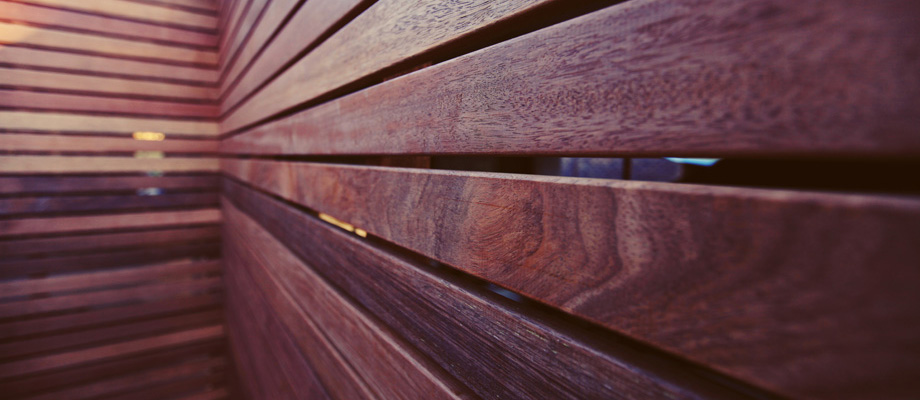A hardwood timber floor represents a long-term investment & with regular cleaning and maintenance, a timber floor can look beautiful for a lifetime. Timber floors are easy to clean & maintain by following a few easy guidelines.
JOB SITE STORAGE
Timber is a reasonably resilient material, but bad handling & poorly organised storage on job sites could potentially lead to damage & wastage.
In order to maintain correct moisture content, physical appearance & discourage any splitting, decaying or discolouration, it is important to store timber products correctly prior to construction.
The packaging around Timber products is designed to protect it during transport only. Store timber products under adequate cover that not only protects the product from weather but is also well ventilated to prevent condensation.
You must always stack timber on a solid, flat surface with even supports & level packers to prevent warping, bowing, sagging, or touching the ground.
GENERAL PRECAUTIONS & MAINTENANCE TIPS
- Dirt & grit can lead to excess wear & scratching of a hardwood timber floor. Use dirt trapping mats at all exterior doors to minimise dirt, sand & grit that might be brought inside. Small rugs & hall runners are also helpful for collecting the dirt that can scratch a hardwood timber floor. Regularly sweep high traffic areas with a soft bristle broom or electrostatic mop.
- Fit protective pads to furniture legs to reduce risk of scuffing the floor when moved. To protect the floor surface use protective mats for furniture with castors. Barrel castors are less likely to damage a floor than ball castors.
- In areas where extreme temperature changes or moisture variation are common, gaps or cupping may appear in the floor. Maintain an ambient temperature to avoid dryness that may cause gaps, & moisture increases that may cause cupping.
- All hardwood timber floors will fade, darken or change shades over time. Exposure to sunlight will increase this process. Rotate rugs periodically & protect the floor from direct sunlight with curtains or blinds.
- High heel shoes can dent a hard floor surface. Remove shoes that have exposed heels with sharp points to avoid potential damage to a hardwood timber floor.
- Pets with long nails or claws can scratch and dull the floor finish, make sure pets nails or claws are trimmed regularly and kept blunt.
- One of the benefits of a hardwood timber floor is that it can be refinished if it becomes excessively scratched or dented. However, it is recommended that you use of a qualified flooring professional proficient in sanding & finishing to complete this work.
CLEANING TIPS
Decking
In order to keep a hardwood timber deck looking its best, it must be kept clean & well maintained. It is a good idea to inspect a hardwood timber deck at least annually to ensure that it is in good condition. The deck must be regularly maintained as it may become discoloured or affected by moisture & weather. Inspect the deck to replace loose boards & protruding nails or screws. Any loose or damaged boards should be resecured or replaced, loose nails hammered back in or screws refixed.
Cleaning your deck:
- Sweep off any loose dirt or garden residue.
- Clean the deck with a specialised deck cleaning product. It is important to not only remove dirt, but any algae or moss that may be growing on the deck.
- After the cleaning is completed, lightly sand the deck in the direction of the timber. This will remove any splinters and damage to the timber.
- Once sanded, reseal the deck with a stain, oil, paint or varnish, depending on aesthetic preference. Before the decking finish is applied, cover areas around the deck that need protection such as plants & furniture. Drying times are dependent on the type of finish so check finish manufacturer’s recommendations before walking on a newly finished deck. Apply & re-apply decking finish as per finish manufacturer’s recommendations. Finish manufacturers may recommend that the decking finish needs to be re-applied more than once a year.
- After a new timber deck has been built, or an existing deck repaired, thoroughly sweep and clean to remove metal filings from drilling, nailing or other construction materials that may cause black spots on the hardwood deck when exposed to the elements. If the deck has turned grey from natural weathering or is discoloured due to metal filings or other construction materials, a solution of oxalic acid crystals mixed with water, a light sanding and a new coat of decking finish will help bring it back to its natural beauty. Use with care and follow the finish manufacturer’s instructions carefully.
Flooring
A hardwood timber floor will look better for longer if it is kept as clean as possible.
- To remove surface dirt and grit, regularly vacuum, with a soft bristle head or an electrostatic attachment, or sweep with an electrostatic mop. Keep door mats clean.
- For stubborn dirt, damp-mop the floor using a well rung mop. The use of a pH neutral floor cleaner can help remove stubborn dirt (use as per manufacturer’s instructions).
- Never clean a floor with common household detergents, polishes, steel wool pads, wax or similar products. These products can be too abrasive and scratch the surface, or may make a floor dangerously slippery. Some products may leave a film of silicon or wax on the timber which may hamper recoating of your floor in the future. Never use Methylated Spirits or Kerosene, as any type of petroleum distillate will degrade the coating and irreversibly dull the floor. Only use a pH neutral floor cleaner as per manufacturer’s instructions.
- Use only quality lint free floor mops and thoroughly wash new mops to remove any lint.
- Wipe up spills and leaks promptly with a dry cloth or dry paper towel. For sticky substances, moisten the cloth slightly.
- Our timber supplier uses a sophisticated processing technology for all kiln dried timber & rigorous floor placement procedures to control the moisture content. Over wetting a floor when mopping or cleaning can change the moisture balance and cause a floor to expand, with some resulting in cupping. For this reason, it is important to ensure that mops and cloths are well wrung so that as little water solution as possible wets the floor.
- Steam mops are not recommended for cleaning timber floors. Steam (moisture) is forced into the joints of the timber and any small incisions, breaks or cracks on the timber floor surface resulting in unusual reactions in the timber such as cupping. The heat from the steam mop could also cause damaged to the coating on the floor.

